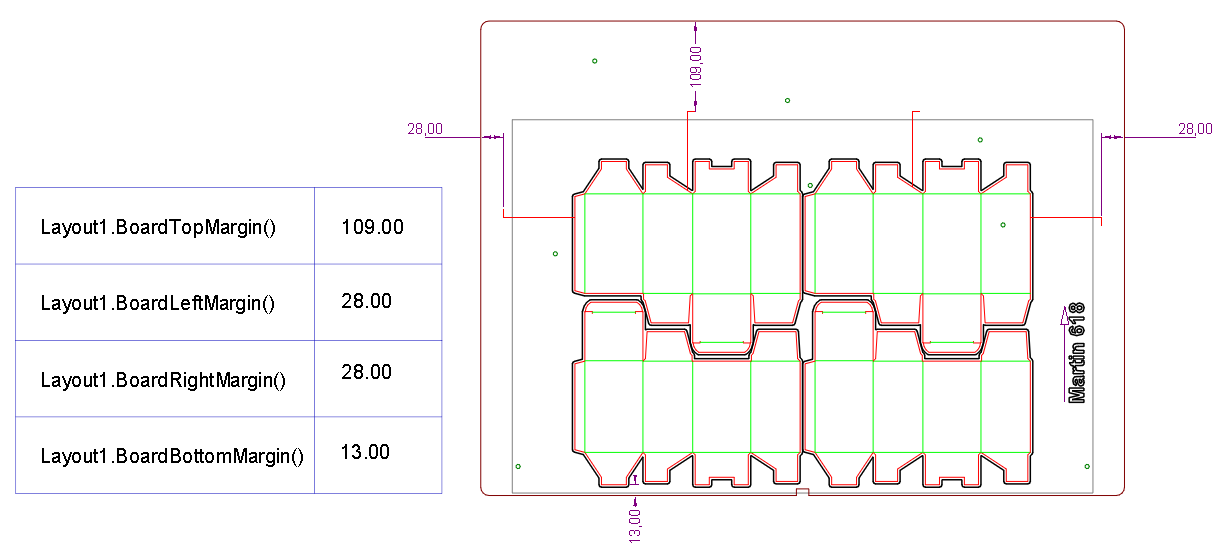| Layout | $LayoutN.BoardName()$ |
| 1up | $OneUpN.BoardName()$ |
NOTE: To see the name of the board you're working with, right-click its edge, and then click Object Properties. The name appears in Name.
The following formulas extract information about dieboards.
| Layout | $LayoutN.BoardName()$ |
| 1up | $OneUpN.BoardName()$ |
NOTE: To see the name of the board you're working with, right-click its edge, and then click Object Properties. The name appears in Name.
| Layout | LayoutN.BoardArea(Units, bFallBackToStyle) |
| 1UP | OneUpN.BoardArea(Units, bFallBackToStyle) |
| To print the board area of | Use | Example |
|---|---|---|
| OneUp1 in default units and rounding. | $OneUp1.BoardArea()$ sq. mm. | 1000.00 sq. mm. |
| OneUp1 in sq. cm. and default rounding. | $OneUp1.BoardArea(m)$ sq. cm. | 60.00 sq. cm. |
| Layout1 in sq. cm. and rounding 3 | $Layout1.BoardArea(cm); n3$ sq. cm. | 65.670 sq. cm |
The formulas that follow return the distances of board's left-to-right edge-to-edge dimension (width) and top-to-bottom edge-to-edge direction (height).
| 1Up | Layout | |
|---|---|---|
| Board Width | OneUpN.BoardWidth(Units, bFallBackToStyle) | LayoutN.BoardWidth(Units, bFallBackToStyle) |
| Board Height | OneUpN.BoardHeight(Units, bFallBackToStyle) | LayoutN.BoardHeight(Units, bFallBackToStyle) |
This function uses the bFallBackToStyle parameter, which controls the measurement of distances in drawings with quasi-dieboards. Learn about quasi-dieboards and how to use this parameter.
| To print | Use | Example |
|---|---|---|
| Layout board's width in cm. | $Layout1.BoardWidth(cm); n0$ cm. | 55 cm. |
| Layout board's height in cm. and default rounding | $Layout1.BoardHeight(cm)$ cm. | 120.45 cm. |
The formulas that follow return board's dimensions as measured along or against the material's flute direction. For example, if the flute goes in the left-to-right direction, the formula returns the board's horizontal dimension; when the flute goes top to bottom, the formula returns the vertical dimension.
IMPORTANT: Do not think of these dimensions as width or height, but rather as along-flute dimension and against-flute dimension.
TO CHECK THE FLUTE DIRECTION: To check the flute direction you are working with, go to the respective 1up drawing and look at the flute direction icon in the upper left corner of the graphical area. The arrow there indicates the flute direction.
HOW TO WRITE THE FORMULA:
| To print the dimension of | |
|---|---|
| Layout | LayoutN.BoardSize(direction; units) |
| 1up | OneUpN.BoardSize(direction; units) |
| To print board size for | Use | Example |
|---|---|---|
| Layout2 along the flute direction in meters | $Layout1.BoardSize(fd(); m)$ m. | 2.34 m. |
| OneUp2 in mm. | $OneUp2.BoardSize(fd(); mm)$ mm. | 2010.35 mm. |
| OneUp2 against the flute direction in mm. and rounding 3 | $OneUp2.BoardSize(fd()+90; mm); n3$ mm. | 1980.340 mm. |
NOTE: If the dieboard has stripping rules, the formulas return the margin distances from the outer edge to the nearest stripping rule; if there are no stripping rules on the dieboard, the formulas return the margin distances from the outer edge to the nearest cutting knife. The formulas ignore structure-irrelevant objects.
| Margin | 1up | Layout |
|---|---|---|
| Left | OneUpN.BoardLeftMargin(Units, bFallBackToStyle) | LayoutN.BoardLeftMargin(Units, bFallBackToStyle) |
| Right | OneUpN.BoardRightMargin(Units, bFallBackToStyle) | OneUpN.BoardRightMargin(Units, bFallBackToStyle) |
| Upper | OneUpN.BoardTopMargin(Units, bFallBackToStyle) | LayoutN.BoardTopMargin(Units, bFallBackToStyle) |
| Lower | LayoutN.BoardBottomMargin(Units, bFallBackToStyle) | OneUpN.BoardBottomMargin(Units, bFallBackToStyle) |
| To print the distance between | Use | Example |
|---|---|---|
| Board's upper edge to the nearest stripping rule in Layout1. | $Layout1.BoardTopMargin(mm); n1$ mm. | 34.2 mm. |
| The board's left edge to the nearest stripping rule in Layout1 in cm. | $Layout1.BoardLeftMargin(cm)$ cm. | 3.44 cm. |
The following example of a layout drawing illustrates how EngView uses the formulas to compute dieboard margins. The formulas use the default measurement units.
